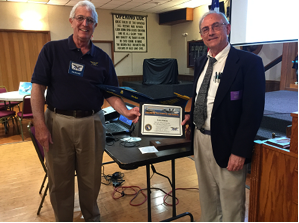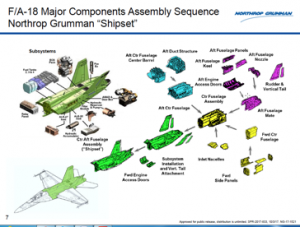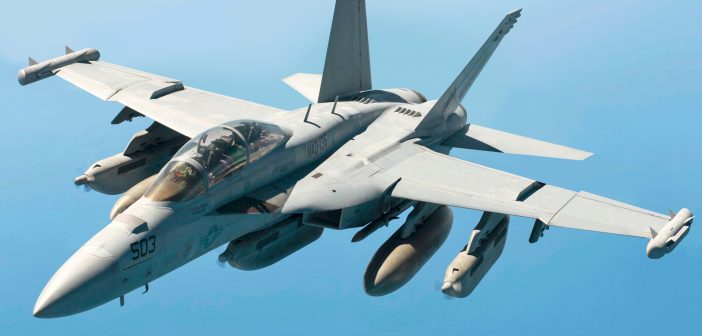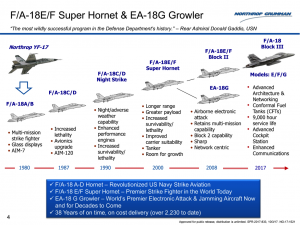 On Mar 8, 2018, the Grampaw Pettibone Squadron was honored to have as its guest speaker, Mr Lynn Jenson. Mr. Jenson a 37-year employee of Northrop Grumman, provided the audience with an overview on the development, evolution and service role of the F/A-18 Hornet, Super Hornet and Growler. This is a twin-engine supersonic, all-weather capable multi-role combat jet, designed as both a fighter and attack aircraft that has served the US Navy, Marines and used by the air forces of several other nations.
On Mar 8, 2018, the Grampaw Pettibone Squadron was honored to have as its guest speaker, Mr Lynn Jenson. Mr. Jenson a 37-year employee of Northrop Grumman, provided the audience with an overview on the development, evolution and service role of the F/A-18 Hornet, Super Hornet and Growler. This is a twin-engine supersonic, all-weather capable multi-role combat jet, designed as both a fighter and attack aircraft that has served the US Navy, Marines and used by the air forces of several other nations.
Mr Jenson initially spoke about his early days growing up near an airport and how his interest in aviation began. He then proceeded to share information on his background in the aerospace industry and some of his early roles at Northrop, which subsequently became Northrop Grumman. With his skill as both an engineer and writer his assignments included work as a Proposal Engineer on aircraft such as YF23, B2, F5 and others. He described a unique commercial bus design by Northrop involving the use of composite materials that while strong enough for vehicle use would enable law enforcement to fire at the vehicle and penetrate the bus body with minimal deflection if engaged in a law enforcement event.
Moving into the core of the presentation, Mr Jenson described the development of the F/A-18 aircraft and business activity at Northrop Grumman. Northrop Grumman is a leading company in the field of global security and retains role in three industry sectors; Aerospace Systems, Mission Systems and Technology Services.
The F/A-18 was designed by McDonnell Douglas (now Boeing) and Northrop. The aircraft came about when the Northrop YF-17 was developed to compete with the F-16 in the US Air Force’s Lightweight Fighter Competition of the 1970s. Though the USAF eventually selected the F-16, the US Navy was exploring the need to select a smaller fighter and felt that Northrop’s concept offered greater potential as a replacement for the aging A-7 Corsair attack fighter. Northrop and McDonnell Douglas agreed to jointly produce an F-18 fighter version for the Navy and an A-18 attack variant for the Marines, but the two missions were later combined. The result was the multi-mission F/A-18 Hornet. The F-18 successfully entered service with both the Navy and Marine Corps during the mid-1980s to replace both the A-7 and F-4 Phantom II.
The initial F/A-18 fighter and attack dual purpose version met service needs effectively. Subsequent development and manufacture of additional models meet on-going mission roles and eventually augment the existing aircraft inventory.
- F/A -18A /B First Flight -1978 Operational – 1983 Multi-mission
- F/A -18C/D First Flight – C -1976 D- 1988 Operational -C 1988 D- 1989 Avionics & Weapons Upgrade
- F/A -18C/D Night Strike – First Flight C-1986 D-1989 Operational C- 1988 D- 1989 Night/All weather, Engine Upgrade, Increased Survivability.
- F/A -18E/F Super Hornet – First Flight -1995 Operational – 1999 Longer Range, Greater Payload & Survivability, Tanker Capable.
- F/A -18E/F Block II – First Flight -2001 Operational – 2005 Advanced Radar, Longer Range, Greater Payload & Survivability.
- F/A -18 E/F Block III First Flight -E-2013 Operational – estimate is 2019
- F/A -18G Growler – First Flight -2006 Operational – 2008 Electronic Attack Network Centric
Our speaker indicated one of the features of the F/A-18 is the inclusion of a leading-edge extension, an extension to an aircraft wing surface, forward of the leading edge. The primary reason for adding an extension is to improve the airflow at high angles of attack and low airspeeds, to improve handling and delay the stall. The capability of the aircraft resulted in it replacing existing aircraft. Beyond the original design parameters, the following is a short list of inventory to be replaced or supplemented with the F/A-18 and it’s various versions; (A1, A4, A6, F8, RA5C, RF8, KA3, KA6, EA6B, S3 and A12).
The F/A-18E/F or Super Hornet version is considered mission capable to replace the Grumman A-6. It was proposed the new stealth attack aircraft A-12 was to be the replacement for the A-6. With the A-12 cancellation the F/A-18E/F model will be the next generation to fill the role. The F/A-18E/F aircraft is physically larger than the earlier versions. Approximately 25% larger airframe, 50% heavier empty weight, 10% longer and about 40% larger internal fuel load.
Following the F/A-18E/F version is the EA-18G, also known as the Growler. This version is the replacement for the EA-6B and will provide tactical jamming and electronic protection to U.S. military forces and allies around the world.
Northrop Grumman produces about 40 percent of the work content for F/A-18 and about 50 percent for the EA-18G. The company manufactures the center/aft fuselage and vertical tails for both aircraft, as well as the airborne electronic attack subsystem for the EA-18G.
As part of the design features for the F/A-18E/F and EA-18G is the addition of conformal fuel tanks(CFG). The design of these tanks enable the addition of fuel sources with tanks designed to be shaped and installed above the wings and conform to the fuselage. Mr. Jenson indicated that initial thoughts regarding the addition of the tanks would increase drag in flight. In fact it reduced drag for better performance
Mr Jenson indicated that current production figures show 2251 aircraft built to date of all versions. In addition to aircraft deployment with the U.S. Navy and U.S Marines, a total of 7 additional countries have acquired different versions of the F/A-18. They are; Canada, Australia, Spain, Kuwait, Finland, Switzerland and Malaysia.

In describing logistics support, it was noted a brief summary of production identified; 12,000 wire harnesses, 23,000 parts and 65,000 connectors. The complexity of the aircraft configuration for each version requires considerable coordination with both primary and sub-contractor support for timely delivery of assigned sections. The accompanying graphic displays the breakdown of manufacturing requirements between Northrop Grumman and Boeing.
In closing, Mr. Jenson opened the floor to questions and responded to inquiries regarding the conformal fuel tanks, stealth capability of each aircraft version, cost comparison between F18 and F35 and EA-18 defensive systems.
 In responding, Mr. Jenson noted that conformal fuel tanks once approved were available for all F/A-18 versions and can be retrofitted to earlier models. The stealth capability of the aircraft is met by the shape of the wing, coatings on the surface of the aircraft and the subsystems capability to mask the aircraft in flight. A straight cost comparison based on initial production numbers is $70 million for the F/A-18 v $90 -100 million for the F35. The EA-18G Growler does not normally come equipped with defensive systems but can be retrofitted if required with appropriate equipment.
In responding, Mr. Jenson noted that conformal fuel tanks once approved were available for all F/A-18 versions and can be retrofitted to earlier models. The stealth capability of the aircraft is met by the shape of the wing, coatings on the surface of the aircraft and the subsystems capability to mask the aircraft in flight. A straight cost comparison based on initial production numbers is $70 million for the F/A-18 v $90 -100 million for the F35. The EA-18G Growler does not normally come equipped with defensive systems but can be retrofitted if required with appropriate equipment.





